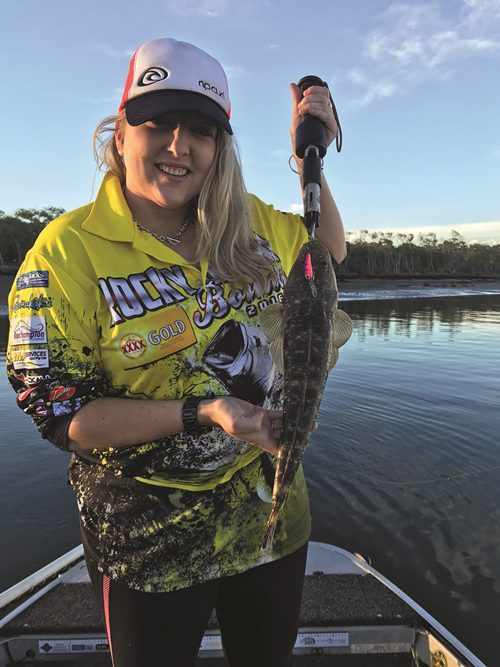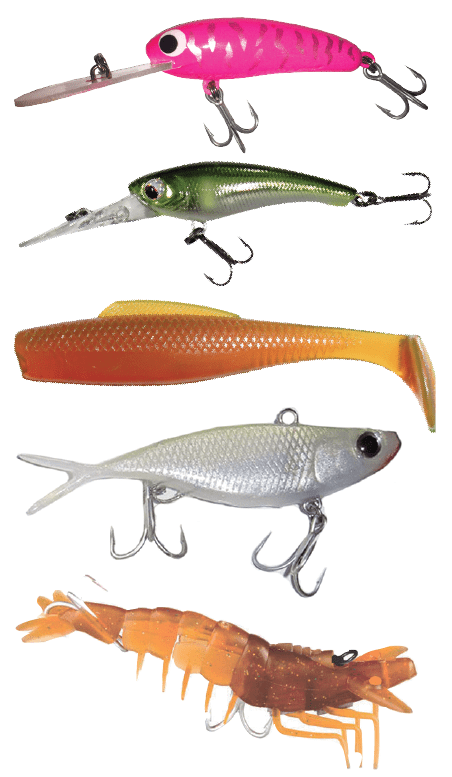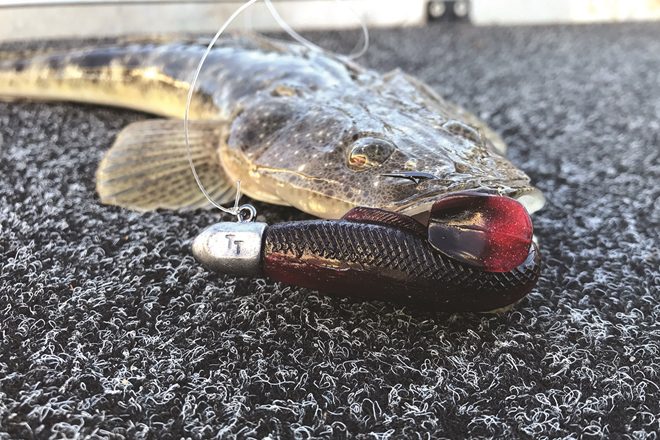FLATHEAD will be one of the species most commonly encountered during July, so I’ll run through a few tips, techniques and the gear I like to use when targeting flathead in southeast Queensland.
Flathead will feed aggressively in the rivers and creeks around Brisbane when the water temperatures drop during winter. I like to focus on the area between Caloundra at the northern end of Pumicestone Passage and the Brisbane River. Every system in this area will see large numbers of hungry flathead on the bite during July. Casting soft plastics is my favourite way to get amongst a few lizards, but trolling, jigging and drifting with bait will also see you catch plenty.
Gear for flathead
Top of the range outfits aren’t needed to chase flatties, though something light and comfortable certainly helps if you’re planning on spending a few hours casting at them. Flathead are a great species on which to introduce people to luring. Numbers are high at this time of year and they will be feeding aggressively, which is perfect for anglers starting out with lures. A light spinning outfit is perfect for casting plastics at flatties and it will also work well for trolling and jigging in deeper water.
I like a slightly stiffer rod when casting and jigging soft plastics because it helps me work the lure more erratically. I find a stiffer rod also helps set the hook better than a sloppy rod. Additionally, something a little stronger is beneficial when a jewie or threadfin finds your lure a bit hard to resist. Jewies can take a long time to bring to the surface when fishing on light gear, even the smaller models of 60-70cm that are common in deeper water at this time of year.
A 2500-size spinning reel is perfect for chasing flatties and when paired with a well-balanced rod will have you casting lures all day without any discomfort. This outfit will also double as a light jew, snapper and threadfin outfit, all of which are also available in good numbers during winter. I like to use braided lines of 8-12lb when chasing lizards. The thin diameter allows me to put in long casts and it also has very little resistance in the water when jigging and trolling. Leader size can vary depending on location. Some areas where I target flatties will have a lot of fallen timber and rocks close by, so a leader of 12-15lb is a bit of insurance when the fish are on the wrong side of the structure. When the water is clear, it can help to drop back to a 10lb leader, but that’s as light as I like to go at this time of year due to the aggressive feeding habits of the fish.



A lot of the plastics cast and jigged at flathead will be engulfed, which will have your leader rubbing across the flathead’s raspy teeth. Anything under a 10lb leader will struggle to stand up to the sharp teeth of a flatty. Always check the leader after every fish, especially if the lure has gone down the flatty’s throat. A worn or scuffed leader could see the next fish you hook swimming away with your favourite lure. Simply cut the damaged leader off and retie the jig head back on. This will take its toll on your leader length and will have it down to 30cm in no time if you find a hot bite.
I have caught flatties with only the braid tied to the lure plenty of times, especially if the fish are hungry. When they get in a mood like this, they will eat just about anything you throw at them. Other days when the bite is tough, you might find you have to run a longer, lighter leader and a perfectly rigged plastic in a certain colour. If I was to choose one size of leader for chasing lizards, it would be 12lb.
Casting plastics for flathead
I find casting soft plastics to be one of the most exciting ways to tangle with lizards. It gives you the opportunity to present a cast in the perfect area and feel the fish belt the lure before setting the hooks. When the water is clean, like it normally is during winter, it’s also possible to see the fish eat your plastic. Quite often, a number of fish will actually follow the plastic all the way back to the boat without eating it.
Many years ago when I used to fish with an old Bribie Island local, we would drop anchor and flog an area until we thought no fish were left before pulling anchor and moving 10m. We soon realised that a lot of the fish were actually following the plastic back to the boat without eating it and were holding in the shadow cast by the boat. Once we worked out what was going on, we would always make a few casts really close to the boat, particularly in the shaded section, before moving on. Quite often this produced a fish.
This was before we had an electric motor. These days everybody has a ‘leccy’, so it’s a little different. But don’t think you can’t successfully catch lizards without an electric motor. Anchoring works a treat too but you need to be quiet and keep noise to a minimum when changing position. We used to run a small sand anchor on a short length of a rope with no chain. When conditions allowed, we wouldn’t even start the motor, we’d just let the current float us down-current to the next area.
This helped keep everything as quiet and stealthy as possible. When throwing soft plastics, I like to have some sort of structure to cast at. This structure can be as simple as a drop-off on a sandbank. Drifting a yabby bank with no undulations or drop-offs can be very hit and miss and will see you covering a lot of dead water between fish. Rocks, weed beds, drains, gutters and fallen timber are all excellent structures around which to find a few lizards.
Flathead love to hold very close to timber, weed and rocks and will quite often sit right on top of it. Casting a soft plastic into a sandy patch among a prolific weed bed is a near-certain way of finding yourself hooked up to a cranky lizard. The same goes with rocks. Flathead love to sit in the sand and rubble patches between rock piles waiting for baitfish to pass by. When you find flatties in areas like these, they are normally only there for one reason, and that is to feed. Once again, a well-presented plastic cast into these areas will not go unnoticed at this time of year.
Timber can be a bit trickier to target because it’s very good at snagging lures. Using a snagless-style jig head works well in these areas. The hook-up rate might not be as high as with a standard jig head, but they’re still surprisingly effective, especially when using a stretchy style of plastic such as those in the Z-Man range. Z-Man plastics are stretchy, soft and very durable, which allows the plastic to pull away from the hook point when a fish bites it. This allows the hook to remain clear and more often than not results in a solid hook-up.
Jig head selection is one of the most important parts of flathead fishing. If you’re fishing too light, you will struggle to get to the bottom in slightly deeper water and when the current is strong. If the fish aren’t feeding aggressively, they will rarely move too far off the bottom to eat a plastic. However, if your jig head is too heavy it will hit the bottom too quickly and restrict the plastic from swimming to its full capability. It’s also possible that a heavy jig head bashing into the bottom will spook any fish close by.
The most common jig head weights I use for flathead are 1/4oz and 3/8oz. Occasionally I will go down to a 1/8oz or 1/6oz if I am casting over mangrove roots or I want to keep the plastic above thick weed beds. In water between 30cm and 1.8m deep, a 1/4oz jig head will work well. In water any deeper than this, I like to use a 3/8oz jig head. Some people think 3/8oz is too heavy for shallow water but the flatties don’t mind and it allows you to work an area quicker.
Jigging for flathead
Jigging deeper water also works well during winter. Many people think flathead will only be up on the flats looking for warmer water, but this is far from the truth. The water temperature on the flats fluctuates a lot at this time of year and this can change the flathead’s feeding habits. In the deeper water, the temperature remains much more constant and the fish will happily feed at all stages of the tide if food is in the area.
When jigging deeper water, I like to target areas with some form of structure, just like I do when casting plastics on the flats. Deep holes are a good place to start looking. Most bends in a river or creek will have a deep hole. These holes will have some sort of drop-off at each end, whether steep or gradual. Flatties often use these drop-offs as ambush points, waiting for schools of bait moving into or out of the hole. These holes are also graveyards for fallen timber. New snags are washed into the holes after each flood and they provide perfect shelter for a range of species including flatties. Large schools of herring congregate in deep holes during winter and they are one of the main food sources for flatties and the many other species that feed in these areas.
A 3/8oz jig head will get to the bottom in most situations. The most important part of jigging is to keep the boat directly above the lure. An electric motor makes this a lot easier, especially if you have a foot control. Electrics with only a remote make it really hard to concentrate on fishing properly and keeping the boat in position. Another area worth jigging around is bridge pylons. Bridges are some of the crustiest forms of structure you will find in the rivers and creeks around Brisbane. They hold nearly every species of fish you can think of at some stage of the year and flathead are one of the most popular. Bridges create huge eddies and back-currents, which give baitfish somewhere to sit out of the main current flow. Unfortunately for the baitfish, the predatory species know this too well and use these areas to feed.
Most bridges are situated in the main current flow of the river and quite often the current will pass through them on a slight angle. This works in the favour of the angler, giving the fish the option of sitting out of the current on one side or feeding into the current on the other side. Jigging is a perfect way to target bridge pylons and once again it can be a lottery as to what will eat your plastic next. Flatties can sit anywhere around bridge pylons, from right against the base to out in the middle. If you can find a bait school on your sounder, it’s well worth jigging straight through it because this is more than likely where a hungry lizard will be.
Trolling for flathead
Trolling is a very effective technique for pinning a few lizards. It’s also an excellent way to get kids involved in lure fishing. I’ve talked a lot about trolling over the past couple of months, so I won’t go into too much detail now. I find I get better results trolling with the tide than against it. Trolling with the tide gets the lure down deeper but also makes the boat cover ground faster. If you find the boat is moving too fast, try putting the motor out of gear and drifting with the tide and wind. As long as the lure is hitting bottom, you know you are in the strike zone.
Some form of lure retriever is a very handy tool to have on board. Trolling the rivers and creeks around Brisbane will find you hooked up to a range of foreign objects. Abandoned crab pots are scattered everywhere. They can be a real pain to get lures off and most of the time one of the trebles will straighten out. Changing the trebles over to chemically sharpened models is a great idea. Good-quality trebles can turn bumps from fish into solid hook-ups. July is a great month to get stuck into the local lizards. They’re good fun and great on the plate.
I hope to see you on the water.
 Bush ‘n Beach Fishing Magazine Location reports & tips for fishing, boating, camping, kayaking, 4WDing in Queensland and Northern NSW
Bush ‘n Beach Fishing Magazine Location reports & tips for fishing, boating, camping, kayaking, 4WDing in Queensland and Northern NSW









